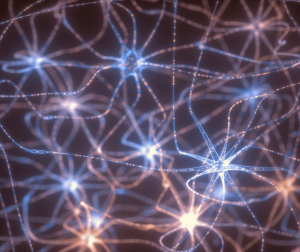CB1 and CB2 Receptors: The Locks That Cannabinoid Keys Open
Posted on October 31st, 2020
You may be aware of the many potential benefits of cannabinoids like CBD. Many studies have been conducted on their effects on mood, pain, inflammation, stress response, and more. However, the question of how and why these compounds work is crucial to understanding them. The answer lies in a vast and sophisticated system that we are still trying to make sense of. This system is the Endocannabinoid System, or ECS. Two of the most crucial components of the ECS are its two main receptors, known as the CB1 and CB2 receptors.
History of the ECS
An initial outline of the endocannabinoid system began during the 1960s. Naturally, it was a result of research into the effects of cannabis on humans. Researchers were able to isolate a number of phytochemicals from the cannabis plant. By closely studying their effects, a web of receptors, biochemical pathways, and enzymes were revealed. These were all found to be involved in producing and using the body’s own cannabinoids. Scientists refer to them as endocannabinoids (endo meaning they originate in the body).
Even though the studies were mostly focused on human beings and other mammals, it turns out we share these neurochemicals with most animal kingdom members. Fish, amphibians, birds and even sea urchins make use of similar systems. Thanks to science, it is now clear that the endocannabinoid system evolved at least 600 million years ago.
Since the endocannabinoid system arose so early and animals became increasingly complex, it developed into a wide array of neurological and physiological functions. In this read, we are going to take a look at how the ECS works along with the most fundamental cannabinoid elements, CB1 and CB2 receptors.
What is the Endocannabinoid System?
The ECS is the main regulatory network that oversees the creation and breakdown of endocannabinoids. It is a sophisticated network of endogenous cannabinoids, CB1 and CB2 receptors, and enzymes. This system is often referred to as the bridge between the body and mind, as it mediates key cognitive and physiological functions.
Functions
The endocannabinoid system is very complex, and scientists have yet to determine exactly how it works and all its possible functions. Thanks to research in the past several decades, the ECS has been linked to an array of bodily functions and processes, including:
-Metabolism
-Appetite & digestion
-Chronic pain
-Motor control
-Mood
-Inflammation
-Sleep
-Bone growth and remodeling
-Reproductive system function
-Learning and memory retention
-Muscle formation
-Cardiovascular system function
-Skin & nerve function
-Stress
-Liver function
All of these functions contribute to homeostasis— the stability of the body’s internal environment. For instance, if a fever or pain from an injury throws off the body’s homeostasis, the endocannabinoid system helps the body return to its optimal function. Scientists and researchers believe that the endocannabinoid system’s overall role is to maintain homeostasis.
Although the CB1 and CB2 receptors are the main focus here, there are many other similar pathways in the body. Both phytocannabinoids (plant-derived) and endocannabinoids (made in the body) can act on these other pathways too, with possibly more awaiting discovery. In this next section, we are going to focus more on the CB1 and CB2 receptors. These are the two that we most actively engage when we consume CBD and other cannabinoids.
 A Closer Look at CB1 and CB2 Receptors
A Closer Look at CB1 and CB2 Receptors
The endocannabinoid system was just truly discovered in the late 1980s. We continue to learn more each day as studies all over the globe grow with the popularity and legalization of cannabis. Until recently, scientists have focused on two primary mechanisms of the ECS- receptors CB1 and CB2. You can visualize them like docks that both phytocannabinoids and endocannabinoids, as well as some terpenes, attach to. Cannabinoid or CB receptors are found in every major system in the human body This includes the brain, nervous system and reproductive organs to the skin, bones and connective tissues.
CB1 Receptor
Cannabinoid-1 receptors are primarily found in the central nervous system, which consists of the brain and spinal cord. Their activation depends on behavioral and cerebral variables. They have a direct impact on motor control, emotions, mood, pain perception, cognition, memory and appetite stimulation. Tetrahydrocannabinol, or THC, has a high affinity for the CB1 receptor. This is why you experience cognitive impairment (highness) when you smoke or ingest marijuana. However, THC is just a supplement of your body’s own bliss molecule known as anandamide. This is an endocannabinoid that binds to CB1, just like tetrahydrocannabinol.
The CB1 receptor has especially vast implications for human behavior due to its role in mediating the body’s reward system and. Rewards lead to further motivations and ultimately to actions. Through continued research, psychologists and neuroscientists are getting closer and closer to unraveling the mysteries behind THC’s effects. It has become clear that a more precise comprehension of CB1 function could provide incredibly valuable insights into the opioid crisis, PTSD, addiction research and human psychology. Many diverse fields of research have taken an interest in the CB1 receptor. Subjects like mental health, PTSD, dependency-related problems, and anxiety disorders are all associated with the reward pathway system.
CB2 Receptors
Cannabinoid-2 receptors are primarily found in the peripheral nervous system and are particularly associated with inflammation and immune system response. Since they are mostly concentrated in the body’s peripheral system, their stimulation does not lead to intoxication or heady euphoria. Activating CB2 receptors can help relax the body, aiding muscle repair and alleviating pain sensation without affecting cognition. Scientists are currently attempting to figure out how to target the CB2 receptor selectively. Doing so could be a substantial boon to people searching for pain relief without the psychotropic effects of CB1 stimulation. Avoiding the nasty side effects of prescription and over the counter medications is another common motivation.
When cannabinoids bind to the CB2 receptors, they show potent pain-relieving (analgesic) and anti-inflammatory properties. The terpene beta-caryophyllene found in many cannabis varieties and black pepper appears to readily bind to CB2 receptors with anti-inflammatory effects. This may explain black pepper’s cross-cultural popularity, especially in folk medicine, for inflammatory gastrointestinal problems. Also, it is important to note that other plants besides cannabis can interact with the endocannabinoid system. CB2 receptors are of particular interest in studies targeting neuropathic and acute pain management in addition to many inflammatory diseases.
 CB1 and CB2 Receptors Relationship with Cannabinoids
CB1 and CB2 Receptors Relationship with Cannabinoids
Similar to a key that fits into a lock, cannabinoids are meant to link with the ECS. When the binding occurs, it prompts the receiving neuron to act. Thus, an array of events begins to pass the message along through cellular responses required for homeostasis and healthy bodily functions.
Your body naturally produces cannabinoids known as endocannabinoids. These are anandamide and 2-arachidonoylglycerol, which are tasked with binding to the receptors in order to ascertain balance. However, plant-based cannabinoids such as THC and CBD also stimulate CB1 and CB2 receptors quite effectively.
Phytocannabinoids act as a supplement in cases where there is an endocannabinoid deficiency. According to research, this condition can result from diseases related to the nervous and immune systems. Administering cannabinoids such as THC, CBG, and CBD can help the ECS maintain its optimal function.
Beyond CB1 and CB2 Receptors
In the cannabis world, cannabinoids are often said to fit into the receptors CB1 and CB2 like a lock and key. Tetrahydrocannabinol certainly seems to, but not all cannabis compounds bind with the receptors like THC does. Take the popular cannabidiol (CBD) for example. In its isolated form, it has little to no affinity to CB1 and CB2 receptors and tends to do most of its work elsewhere.
And it is not just cannabidiol. According to studies, a number of other cannabinoids do not have any affinity to either primary receptor. They may, however, interact with about 15 other channels in the human body. TRPs, GPRs, and PPARs are a few other receptors believed to interact with the endocannabinoid system directly or indirectly. There are likely many other cannabinoid receptors that science has yet to identify.
Final Thoughts on CB1 and CB2 Receptors
The ECS is like a fingerprint— everyone’s is a little different. It is the reason tolerance varies greatly from person to person, and why we experience cannabis effects differently. Because CB1 activation is subjective, we are likely far from being able to precisely explain the psychotropic effects of cannabis.
However, when it comes to the receptor CB2, effects such as tension release and pain alleviation are not subjective. So if you are searching for pain relief without intoxication, keep cannabinoids in mind! Tanasi offers the highest quality, full-spectrum hemp extract products on the market. Their products are a result of millions of dollars of scientific research and a patent-pending combination of cannabinoids.

 A Closer Look at CB1 and CB2 Receptors
A Closer Look at CB1 and CB2 Receptors CB1 and CB2 Receptors Relationship with Cannabinoids
CB1 and CB2 Receptors Relationship with Cannabinoids



